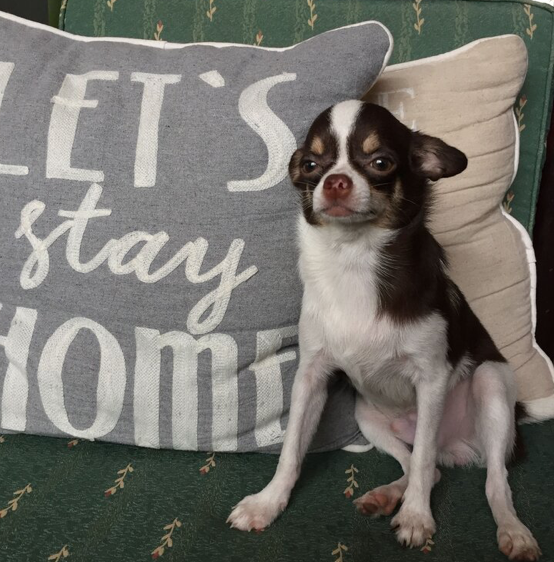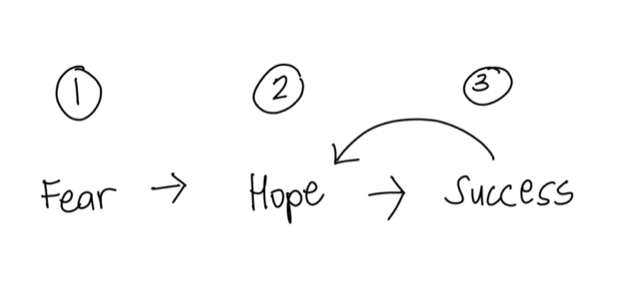Fear vs. Hope: Which Is Better for Your Brand Messaging?

Out of our three chihuahuas at home, Ringo is the least picky with food.
Every time we set the table, he hurries into the room and charms us with his puppy eyes until we feed him before the other dogs.
So when he ignored his kibble one day, we worried.
The meal skipping was alarming in itself, so when he started vomiting and showing signs of diarrhea, we rushed him to the nearest vet clinic.
It turned out that Ringo was positive for parvovirus.
Because Ringo was only four months old then, the vet listed all the reasons he might not make it through the night. I was holding my breath the whole time, imagining what it would be like to lose Ringo that fast. The vet dropped scary statistics and sad stories, convincing me that Ringo’s best chance to survive was confinement. Yet, he reminded me that even then, Ringo might still not pull through.

*The purpose of this blog is to discuss how you can use fear and hope in your marketing. I don’t mean to promote one brand and tear down another, which is why instead of using their business names, we’ll call them Vet Clinic A and B.
Let’s talk about Vet Clinic A
Though I’m grateful to the vet and staff who nursed him to health, I won’t forget the experience. They keep their clinic clean, and they offer convenient payment options like credit cards and Gcash. Also, they organize records, receipts, and prescriptions well (I can be a Monica at times, so this counts).
There are a few buts, though.
- They charge higher than usual. Or the price just wasn’t right for my pocket.
- The lines are always loooooooooong. I had to cut my workdays short for a couple of days because of this.
- I appreciate that the Vet Clinic A people were cautious, but I wish they were more hopeful. Maybe they only didn’t want to overpromise — some people might prefer this approach, but I don’t. I want to hear both the good and the bad. To see a bright tinge of hope in the background of a gray reality. I know it sounds melodramatic but that’s me!
How Vet Clinic B is different
Weeks after Ringo recovered, his brother Johnny caught the parvovirus, too. My aunt and I rushed him to a different clinic, curious how they’ll handle the case.
And it was a different experience. The wait didn’t feel like forever. Everyone was accommodating, and the vet explained how each treatment could go, helping us decide sensibly. Though the vet and staff were careful, they were more hopeful than those at the first clinic.
So instead of leaving Johnny at the clinic as we did with Ringo, we brought him home and treated him as the vet advised.

Both clinics delivered the results we hoped for: Our chihuahuas are now hale and hearty. But guess which one became our go-to clinic?
You bet it was Vet Clinic B!
This whole experience inspired me to write about fear and how it’s used in marketing, especially when promoting brands.
Fear sells
In 1979, Amos Tversky and Daniel Kahneman identified the loss aversion bias. It states that we are willing to risk more to avoid loss than to make a gain. “The pain of losing is psychologically about twice as powerful as the pleasure of gaining,” describes a behavioral economics resource.
“In everyday life, loss aversion manifests as risk aversion.
For instance, say you have an investment opportunity whereby you have a fifty percent chance of quintupling your initial investment and a fifty percent chance of losing your money. This is a reasonable risk to take, as the potential gain is considerably higher than the potential loss.
Yet neuroeconomic studies by the likes of Daniel Kahneman, Amos Tversky, Richard Thaler, and others have shown that for many humans, the potential pain of a loss overwhelms the brain’s computational processes and might prevent you from making a rational investment bet.”
— MasterClass
We value an item more when we’re about to give it up than when obtaining it. So we tend to steer clear of losses because “losses loom larger than gains” (Tversky & Kahneman, 1979). Even when the probability of losing is tiny.
Have you noticed how your customers react to free trials and limited-time offers?
Many factors may influence your customer’s buying decisions. But when you understand how loss aversion bias affects their habits, you can craft better marketing strategies.
But don’t bank on fear alone
Last week, I was walking in a park with friends when the topic of #adulting came up. We were talking about savings and investments when one of them pointed out how some life insurance companies present themselves as doomsday heroes.
They paint our future selves as helpless people and themselves as the hero that swoops in to save the day. Instead of empowering us to take control of our financial life and build a legacy for our loved ones, they exploit our deepest fears — loss and death — to scare us into signing.
Does it work? Maybe for some.
Does it always work? I doubt it.
Despite the benefits of using loss aversion bias in our marketing efforts, a study in social marketing “shows that the use of negative appeals (fear, shame, and guilt) can also invoke self-protection and inaction rather than an active response such as volunteering to comply.”
Developed by Kim Witte, the Extended Parallel Process Model(EPPM) attempts to predict how people react to a stimuli of fear. A journal examining college students’ responses to antismoking messages referred to this model as well:
If people are too fearful, they expend their energy controlling the fear instead of reducing the danger by getting out of harm’s way.
When a vulnerable person feels threatened but lacks the efficacy to bring about change (e.g., the smoker who is worried about health and has tried to quit but failed), fear is the end result.
Fear in turn can trigger denial, aggression, and the likelihood of riskier behavior.
Fear vs. hope: Which is better for your brand messaging?
Though fear is a powerful motivator, it might not always be enough to foster customer loyalty.
Here’s a simple model that illustrates what I realized why Vet Clinic B earned our trust.

Fear may have pushed me to settle with Vet Clinic A the first time around because I got scared of what could happen if I didn’t do as they recommended. But that same fear is now redirected towards them. I can’t disassociate the discouragement from their brand anymore!
Think of how dementors suck Harry’s joy. That’s kinda how it feels when I pass by their clinic or remember the times I was there.
Contrast that with Vet Clinic B.
They didn’t focus on fear alone but gave us a balanced view of the situation. Because of this, I associate them with hope and pleasant results, not fear.
This model shows that fear can push you to sign up for a service or buy a product once. Yet it’s not enough to motivate repeat purchases nor customer loyalty.
An amusement park advertisement that stirs up FOMO might get you to buy a ticket so you can join your friends. But what would convince you to come back? It could be the quality of service, the politeness of their staff, and the wonderful experience you’ve had. Not fear.
When brands appeal to our pain points, we may try their offers. But what motivates us to stick around and stay loyal is the hope of improving ourselves and our lives.
Once we achieve that through a service or product, we no longer anchor our buying decisions on fear. We make choices inspired by hope for repeated successes and satisfying results. More often than not, our love for the brand grows as it delivers its promises.
So, should you use fear or hope when promoting your business?
Vikas Lachhwani, the founder of MCaffeine, wrote an interesting LinkedIn article that compares the short-term benefits of fear-driven messaging with its long-term effects on branding. It captures what I shared about my struggle with disassociating negative feelings from Vet Clinic A.
Marketing of fear is very effective in driving a positive short-term outcome i.e. the sale. Here, the benefit of incremental propensity is immaterial compared to a favourable binary outcome.
The challenge is in driving Brand Association with marketing of fear.
Humans are emotionally anchored beings. Fear connects them to their anchored fears and hope connects them to their anchored desires. A brand that promotes fear driven messaging is connecting the brand to innate fears of the viewers. People may act under fear but do not want to associate with something that drives them to relive their hidden fears.
Some are motivated by fear, while others are empowered by their hopes. This is why it’s so important to know your customers well: What draws them to your brand? What benefits matter most to them? How can you keep them happy?
The most helpful business insights you can find come from your very customers. And you can use these to craft a brand messaging that resonates with your market.
Fear or hope?
Your customers most likely know.
Check out other resources:
Let fear help your business, not hurt it
- Fear, hope and love: the three marketing levers
- How to Grab Attention Using Fear (Without It Blowing up in Your Face)
- Prospect Theory and Loss Aversion: How Users Make Decisions
Originally published on Prodigy, the digital agency that helps purposeful e-commerce businesses grow their revenue with proven digital marketing strategies.